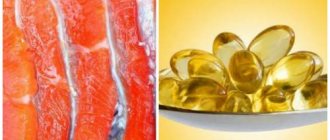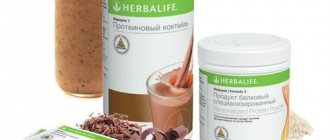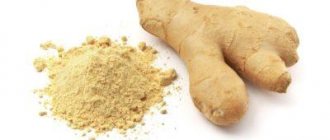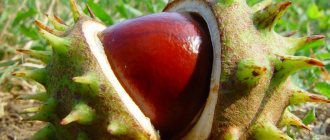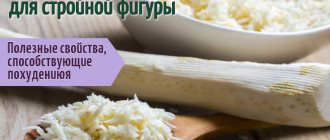A green aloe vera plant with thick, fleshy leaves that grows in the garden or as a houseplant in a flowerpot on a window is not just a decoration. What kind of plant is this, aloe vera, medicinal properties and contraindications, use internally and for the face, today in this article. Why is this mysterious plant so widespread?
Plant extracts are gradually appearing in everything we use. This is the basis of an entire industry that earns millions of dollars annually from creating a wide range of products - from creams to juices and dietary supplements.
An aloe vera flower, planted in a pot, grows no more than half a meter high, with needle-like leaves that taste bitter, which is its protection from being eaten by animals and insects. In nature, a succulent can grow up to 4 meters. Its homeland is considered to be the island of Barbados, which is located next to the Arabian Peninsula.
Aloe vera medicinal properties and contraindications
It is curious that this succulent, aloe vera, has about 500 different species, but only 15 of them have healing properties. These include agave, which people grow on their windowsills with love and care. The medicinal properties and contraindications of aloe vera have been studied in folk and traditional medicine for several millennia, and new interesting aspects appear each time.
Plant preparations are used internally, given as injections, and widely used at home to care for the skin of the face, body, and hair. Look at the photo to see what types of this plant are found in nature:
Chemical composition of leaves
Aloe leaves contain a viscous, clear and very bitter gel known throughout the world for its healing properties. This gel is 96 percent water. Some organic and inorganic components are noted in its composition: rabarberone and glycosides, nanoloin and polysaccharides, chromones and sterols, resinous substances. This viscous liquid contains 18 of 20 amino acids identical to those found in our body, as well as vitamins B, A, C, E, about 12 in total, 200 enzymes, essential oils, and about 20 useful minerals.
Aloin is considered a particularly popular substance, which imparts that very bitterness to the plant. Since ancient times, all peoples have used it as a diuretic. Its laxative effect is so strong that pharmacists mix it with other substances that, at least slightly, neutralize its effect.
But aloin also has another worthy property: it perfectly protects the skin from exposure to ultraviolet rays, which is why the cosmetic industry actively uses this component in creams and gels. Watch the video, aloe ara medicinal properties and contraindications.
Another valuable element contained in aloe leaf juice is a complex of carbohydrates, which is also known as acemannan or mucinous polysaccharide. By connecting with each other, they form legtins that prevent the formation of small capillaries in tumor tissues. And without blood supply, tumor cells soon die.
Acemannan encourages immune cells to work more actively and devour all foreign cells, which allows traditional medicine to use these important properties in the fight against cancer.
Aloe vera medicinal properties
The healing properties of aloe vera are due to the healing substances included in its composition. They give such a wide range of properties. What are the benefits of aloe juice, the succulent plant is different:
☀ Antibacterial properties, therefore the leaves of the plant and its preparations are used in the fight against streptococci and staphylococci; the preparations destroy dysentery and diphtheria bacilli, intestinal and typhoid bacilli.
☀ Antifungal and antiviral features appear. These important medicinal properties of agave are given by acemannan, which is mentioned above, amino acids and vitamin C. Therefore, it is used to improve health in case of respiratory diseases and runny nose.
☀ The plant has antiseptic and anti-inflammatory properties due to the content of steroid molecules, bradykininase enzyme and salicylic acid.
☀ Phenols, enzymes, manganese, copper and vitamins give the antioxidant and antitoxic properties of aloe.
☀ In addition to this, the plant is characterized by other signs:
- laxative and choleretic,
- hypoglycemic and analgesic,
- anticancer and antiallergenic,
- regenerating and wound healing.
☀ The medicinal properties of the plant have a beneficial effect on the body's metabolic processes, activate the digestive glands, relieve inflammatory processes in the gastrointestinal tract, bile ducts, and help normalize the functioning of the gallbladder.
☀ Break down cholesterol plaques and lower blood cholesterol levels.
☀ Activate the growth of fibroblasts, which promotes skin rejuvenation through enhanced nutrition, moisturizing and toning. And regeneration during the healing of small wounds occurs without the formation of scars. Relieves skin irritation and itching.
☀ Promote healing of wounds after sunburn, stimulate skin functions in case of pustular infections and other skin diseases.
What are the dangers of aloe vera contraindications and overdose?
Despite its effective medicinal properties, aloe has numerous contraindications.
Since aloe vera has a laxative effect, it should not be used with other laxatives. It must be remembered that all diuretics remove potassium from the body.
The drugs can also affect blood sugar levels, so patients with diabetes should use them with caution. Glucose levels should be constantly monitored.
It is not recommended to use folk and pharmacological remedies from agave for pregnant women, children under 3 years of age (internally), and women suffering from heavy menstruation.
Aloe juice can be harmful if consumed in the evening before bed and can cause insomnia.
Aloe juice is prohibited if:
- exacerbation of chronic diseases,
- for severe heart disease and hypertension,
- in case of acute disruption of the digestive function,
- with hemorrhoidal bleeding.
Overdose and side effect . Violation of the drug preparation recipe and instructions for use can lead to an overdose. It is especially dangerous to get carried away with fresh juice; the antiglycosides contained in the juice cause poisoning. As a rule, it is accompanied by inflammation of the intestinal mucosa, loose stools with bloody discharge. Blood is also observed in the urine.
In pregnant women, the use of aloe can cause miscarriage.
The leaves and the skin should not be used for a long time. It contains aloin, which has carcinogenic properties. American scientists conducted studies on rats whose food was mixed with an extract prepared from a whole leaf of agave. 50 percent of the rodents studied developed malignant tumors in their intestines.
Therefore, be careful with all medications, be it aloe injections, juice taken orally, drinking gel or gel applied to the skin.
§ 1. General description
Aloe Vera is a unique plant, the medicinal properties of which, with the development of new recipes, are reflected even in getting rid of the most unexpected diseases. For hair, face, body, internal organs - aloe juice is indicated for use.
Aloe Vera juice is extracted from the pulp of the plant itself, which is popular today in folk and traditional medicine. It is made for various purposes - from producing your own juice with a small addition of alcohol to making drugs.
Such a strong interest in this plant has increased the demand not only for pharmaceutical Aloe products, but also for everyday products containing it. Treatment with Aloe Vera juice often exceeds all expectations, and its regular use can completely eliminate the disease.
Therefore, an increasing number of companies around the world are studying this mysterious plant, producing and distributing Aloe products.
There is not a single plant in the world for the sake of which an entire international institute was created - but Aloe Vera has it! This is the IASC, which has been successfully operating for more than 35 years, and oversees all production of drugs from this variety.
Aloe is unpretentious and can be grown at home. Its juice comes to the rescue in a variety of situations - all you need to do is cut off a leaf and use it as needed.
However, it is important to understand that it is impossible to achieve a perfect product without carefully caring for the plant and creating laboratory conditions. After all, this is the only way to get a quality product.
to contents
Aloe juice internal use
Aloe vera juice is used in various forms. At home, fresh juice is squeezed, tinctures and syrups are prepared.

One of the most valuable elements contained in aloe leaf juice is a complex of carbohydrates, which is also known as acemannan. It allows beneficial substances to enter cells, nourish and support them, while simultaneously releasing toxins.
Ayurvedic teachings, Chinese folk methods and ancient treatises consider the use of aloe vera to be a healing agent both for external use (compresses, masks, rubbing) and internal use. Let's look at the most useful and effective ways to use aloe leaves and how to prepare aloe juice at home.
For gastrointestinal health
According to folk recipes, fresh aloe vera juice is recommended for use by people who have low stomach acidity, suffer from constipation, enterocolitis and colitis, and biliary tract diseases. And just like a drug that stimulates the appetite of the digestive system. Among other things, the juice also helps with a lingering cough. Recipes for the stomach:
Prescription 1. Three times before meals, take a teaspoon. For gastritis, treatment with juice will take a long time, up to 2 months.
Prescription 2 . For the stomach, combine 100 g of goose fat, cocoa powder and honey. Add 15 ml aloe juice. Stir and eat a tablespoon at a time, stirring the healing composition in a glass of hot milk. If it is impossible to purchase goose fat, replace it with butter, only this time you will have to exclude cocoa from the recipe. In the second case, there is no need to dilute with milk; take it twice a day, one tablespoon at a time.
Aloe vera use for stomach cancer
I would like to immediately make a reservation in oncology: do not rely only on traditional methods. Use them as aids.
Prescription 3. Add 2 tablespoons of biostimulated juice to 500 ml of cognac. Separately, make an infusion of geranium leaves: 3 parts of finely chopped leaves, pour 3 parts of boiling water and soak for 6 hours in a water bath. After straining and bringing to the initial volume, pour the infusion into cognac. And add 5 drops of 5 percent iodine tincture here.

The drug is drunk three times a day without an empty stomach. The recipes say that after two days, pain appears, but later it goes away, which is considered a good sign on the road to recovery.
To support weakened immunity in oncology
As usual, patients need good nutrition, rich in vitamins. Therefore, biostimulants with aloe juice are a good help. Directions for use:
Prescription 4 . Prepare a mixture of 300 g of honey and 500 g of walnuts, add 100 ml of juice and leave for about a month in the dark. Eat the mixture three times a day, one tablespoon at a time, before meals.
Instructions 5. Prepare carrot and beet juice, radish and black currant juice, cranberry juice and birch juice, juice of St. John's wort leaves and juice of 10 lemons in equal parts. Add 200 ml of alcohol and 500 ml of honey to the juices and leave in the dark for three weeks, remembering to shake the mixture. After straining, drink 30 ml three times before meals.
Instructions 6. Prepare 100 ml of juice of yarrow and calendula leaves, aloe juice and meadowsweet. Mix 50 g of licorice roots in powder and stirring, warm the mixture, but do not bring to a boil. Drink the medicine three times a day, before meals. Store in a cool, dark place.
Instructions 7. Dissolve a kilogram of honey in a water bath and mix 250 ml of aloe juice into it. Separately, make a decoction of 500 ml of birch sap, birch buds (25 g) and St. John's wort (25 g), keep it over low heat for about 10 minutes. Then mix with honey, add 100 ml of vegetable oil and distribute into bottles, put in the refrigerator. Drink three times a day, before meals, shake before use.
To strengthen the physical strength of the body
Prescription 8 . Prepare equal parts of butter and lard (can be replaced with goose fat), aloe juice and honey, ground dry rose hips into powder. Heat the mixture well, but do not bring it to a boil. How to use? Three times a day, before meals, a tablespoon dissolved in a glass of hot milk.
Prescription 9 . Prepare a solution from aloe juice (150 ml), honey (250 g), red grape wine (350 ml), rose hip powder (100 g), ground parsley seeds (30 g). The healing solution should be infused for two weeks in a dark place, shaking occasionally. Drink the medicine three times a day, 30 minutes before meals.

Prescription 10 . Prepare a solution of aloe juice - 100 ml, chopped walnuts - 500 g, honey - 300 g, dry parsnip root powder. After mixing, store the drug in a dark and cool place. Drink three times a day, 30 minutes before meals.
To activate metabolic processes
Prescription 11 . Mix 15 ml of squeezed agave juice with honey (250 g) and red wine such as Cahors (350 ml). Store in a dark and cool place for up to a week. Drink three times a day, before meals, a tablespoon.
Instruction 12. Agave leaves of 5 years of age, keep in the refrigerator, chop and pour boiling water. Maintain a ratio of 1:3. Leave to infuse for 2 hours and strain. Add 500 g of chopped walnuts and 300 g of honey to the infusion. Take three times a day, before meals, a tablespoon.
During menopause to improve bowel function
Aloe juice with honey. Add 300 ml of heated honey (in a water bath) to 150 g of finely chopped leaves. After 24 hours of infusion, reheat and strain. Drink once a day, in the morning on an empty stomach, a teaspoon.
Use in folk medicine for gum inflammation
Grind 100 g of agave leaves into a paste and let the paste sit for about an hour. Then heat it over the fire, without bringing it to a boil, and pour it into a glass container with a ground stopper. Dilute 2 teaspoons in 50 ml of water and rinse your mouth.
For a compress for sore throat and arthritis, pneumonia
Mix one part aloe, 3 vodka and 2 honey. Moisten a piece of cloth with this mixture and apply a compress to the sore spots. Don't forget to put some insulation on top of the bandage.
Aloe juice in the nose
The plant has long been used for the common cold. Moreover, not only home remedies are used to treat a runny nose, but also ready-made medications. The treatment is quick and effective, nasal congestion is relieved and inflammation of the mucous membrane goes away. And all this thanks to the healing properties of the antibacterial action.

Is it possible to put juice in a child's nose? The treatment is effective not only for adults, but also for children over 12 months. But it is necessary to consult a doctor and accurately determine the nature of the disease. If the disease is viral, it is not recommended to put aloe juice in your nose.
How to put drops in a child's nose? For children from one year to 12 years old, before instillation, the juice is diluted with boiled water in a ratio (1:3). Drop 3 drops into each nostril, three times a day. Treatment lasts 5 days.
For adults and children over 12 years old, the juice is diluted in a 1:1 ratio.
Treatment with aloe juice for pyodermatitis
Inflammations of the skin of a pustular nature, including acne vulgaris, are often a consequence of the development of Pseudomonas aeruginosa and staphylococcus. Therefore, patients are prescribed either injections of aloe extract subcutaneously, 1 ml, for two weeks and up to 2 months, or taking the juice three times a day, a teaspoon before meals.
For vasculitis and vitiligo
Succulent juice is used as a herbal medicine that activates the adrenal cortex and metabolism. To do this, traditional medicine recommends taking the juice three times a day, a teaspoon, before meals.
Application in gynecology
More often, for gynecological problems, especially inflammatory processes, aloe is used in injections.
Cervical erosion . At home, aloe juice is used to treat cervical erosion. To do this, soak a tampon and insert it into the vagina for 2-3 hours.
Adhesions and scars are treated with pharmaceutical aloe extract in ampoules. The number of injections is determined by the doctor.
Uterine fibroids. Aloe syrup is taken for treatment. To prepare it, you will need a paste of aloe leaves (200 g), 600 g of honey, 600 ml of red wine and 3 tbsp. l finely crushed roots of the beech plant. The mixture must be heated in a water bath. After cooling and straining, store in the refrigerator.

Recipe 2. Another recipe for curing fibroids. Pour 2 tablespoons of dried sea buckthorn berries into a liter of boiling water, and add a tablespoon of chamomile. After boiling, remove the mixture from heat and cool, then strain. Separately mix 2 tablespoons of vodka and 3 tbsp. l. agave juice and mix with the prepared decoction. Take three times a day, a tablespoon. It is important to remember that the instructions for use must be followed. The same recipes are used when planning pregnancy.
At the pharmacy you can buy aloe extracts in injection ampoules, eye drops, and liniment.
Biology of the species
The natural range of aloe vera remains unclear. The plant was introduced to many countries, where it successfully took root. Today it is cultivated on plantations in different parts of the world, and grown at home almost everywhere.
In the wild, the plant is distributed in the coastal regions of Africa, mainly northeastern. It is also found in the Arabian Peninsula, Canary Islands and Madeira.
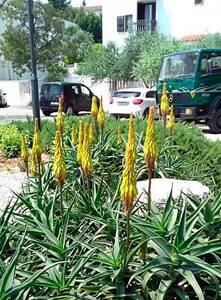
Aloe vera as a street plant in Dubrovnik, Croatia
Aloe vera grows in hot, dry climates that are unfavorable to most other plant species. It is found on sandy and rocky soil in deserts, semi-deserts and mountains. The succulent is adapted to high temperatures and long periods of drought. It can go without watering or rain for about 2-3 months.
During the spring and summer, aloe vera grows actively, and in the fall and winter it begins a dormant period. It ends with a new flowering, which occurs in March-April. Due to the gradual opening of flowers, it lasts about one and a half months.
After flowering ends, an achene with small dark brown seeds is formed on the peduncle. With their help, aloe spreads in natural conditions. The plant also reproduces using basal shoots that appear in early summer.
Use of aloe juice for skin
Bill Coates, a famous dermatologist, believes that the skin needs special care. Aloe regulates water balance, heals, exfoliates, restores and provides constant nutrition to human skin. If you apply enveloping aloe gel to your skin, you will feel how it soothes and cools. In Ayurvedic medicine, aloe vera is considered a miracle plant that heals wounds, cuts, burns and moisturizes dry skin.
With dilated capillaries on the skin
In the morning or evening, lubricate the skin with dilated capillaries with pieces of biostimulated aloe leaf. The skin should be clean and can be wiped with green tea infusion beforehand. After lubricating with juice, to improve absorption, make patting movements with your fingertips. Finally, apply a nourishing cream to your skin. There may be a tingling or burning sensation; this is normal. Carry out the procedure every other day, 12 times in total.
For psoriasis
Prepare a mixture of equal parts (25 g each) of agave juice, celandine, calamus root and linseed oil, cocklebur herb and table vinegar. Pour 400 ml of boiling water over the well-mixed mixture and leave for two hours. Apply the medicine in the form of compresses to the affected areas of the skin.
For purulent discharge from the eyes and inflammation of the eyelids
Pour 2-3 drops of aloe juice with hot water, cool and rinse your eyes several times a day. This aloe water can be used to wash wounds and abscesses.
In case of inflammation of the eyelids, apply lotions to the eyes by placing tampons soaked in the solution on the eyelids for 15-20 minutes.
For burns
If the burns are minor, then cut a well-washed agave leaf lengthwise into two halves and apply to the affected areas of the skin.
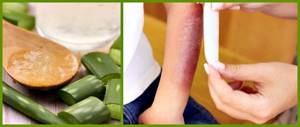
For erosion and dermatitis
Agave juice is used to lubricate sore spots. To enhance the effect, use recipes 6, 7, 8, which strengthen the body from the inside.
For herpes and wounds
Frozen pieces of juice are applied to the affected areas when a herpes rash occurs. Small wounds are dusted with powder from dried agave leaves, and a loose bandage is made on top.
Treatment of boils
An agave leaf, after removing the outer skin, is applied to the inflamed area. It accelerates the maturation of the boil and helps draw out pus. To wash the wound, use an infusion of fresh agave leaves.
Aloe juice for acne
Pour a glass of boiling water into two tablespoons of finely chopped agave leaves. Leave for about two hours. After filtering, wipe the acne-affected face with a swab.
How is the plant useful?
A plant with such a unique composition has many beneficial properties. Healing products based on aloe help with many pathologies and have the following actions:
- remove toxins;
- moisturize the skin;
- improve digestion;
- strengthen a weakened immune system;
- promote the absorption of nutrients;
- have an antiseptic effect;
- maintain acid-base balance;
- reduce cholesterol levels;
- help strengthen the musculoskeletal system;
- thanks to antioxidant effects, they slow down the aging process;
- prevent the occurrence of cardiovascular diseases.
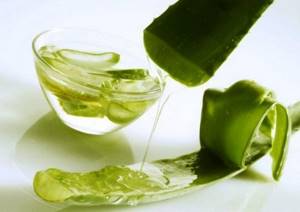
In addition, the plant has antifungal and bactericidal properties.
Benefits of agave juice for humans
Aloe juice is used both fresh and concentrated. It is also included in the following compositions:
- gels;
- syrups;
- medicinal ointments;
- liquid extracts;
- cosmetic regenerating products.
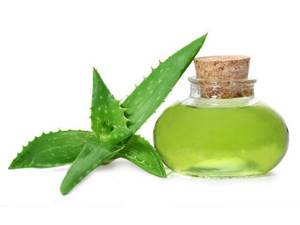
In certain cases, medications with aloe are administered intramuscularly.
You can prepare fresh gel yourself. To do this, juice is squeezed out of large, dense leaves, which must be applied immediately. You can also prepare agave juice in the form of syrup. The healing composition is obtained by mixing the gel, sugar, ferrous chloride.
How to make biostimulated aloe juice
How to prepare aloe juice. Traditional medicine advises using only leaves that are 5 years old. Usually the lower and middle leaves are cut off. An important point is the biostimulation of leaves. This is the aging of fresh leaves under certain conditions.
Cells of the leaves of a heat-loving plant, once in the cold, begin to actively produce biostimulants with unique properties to ensure their vital functions. Therefore, the healing properties of such leaves increase several times after being kept in the refrigerator.
Wrap the leaves in wrapping paper and place them on the middle shelf to reveal all their medicinal properties for about two weeks. And after that, use them to prepare tinctures and decoctions.
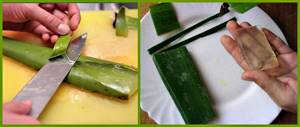
The leaves can be dried, losing water, they become wrinkled and brittle. Dried raw materials are stored for 2 years. Dried, peeled and crushed aloe is used as a laxative, but its effectiveness has not been proven.
§ 6. Cooking recipe
For those who decide to make their own juice from Aloe foxes, there is a simple recipe.
- Keep the leaves of an adult plant (3-4 years old) in the refrigerator or other dark place with a temperature of 4-8 degrees for 12-14 days.
- Next, rinse in cold boiled water,
- Peel thoroughly;
- Grind the resulting jelly-like mass and squeeze out using thick gauze.
- You need to use the resulting juice immediately. Moreover, it loses its properties in a short time. Therefore, its suitability is limited to a few applications, after which the preparation procedure will need to be repeated.
This juice can be added to recipes for preparing any products, for example, for the face and hair.
In addition to its widespread use in folk medicine, the plant is also popular in cosmetic medicine. Let's look at this in more detail below.
to contents
How to make aloe juice at home
To do this, you will need one aloe leaf, kept in the refrigerator, 250 ml of water, pieces of fresh pineapple or citrus fruit and honey. Cut off the top of the leaf with a knife as thin as possible. And mix all the ingredients in a mixer. Add honey to taste as the gel of the leaves is very bitter.
How to take aloe juice. The finished drink must be drunk immediately after preparation. It is not worth storing it, because all vitamins and active substances are destroyed after 15-20 minutes after preparation. It is better to drink the drink on an empty stomach, once a day, preferably in the morning. By drinking the drug in the evening, you can deprive yourself of sleep.
Aloe vera its medicinal properties and contraindications are amazing. Its qualities not only provide health and nutrition, but also have a rejuvenating effect.
- Read: Aloe vera gel for beauty at home
Use this succulent for yourself and be healthy!
For the treatment of joints
The juice of the leaves of the plant reduces pain and relieves inflammation.
Reference! It is advisable to use aloe in the initial stages of joint disease; with severe deformation of cartilage tissue, traditional methods of treatment are powerless.
- To reduce joint pain, grind a peeled aloe leaf into a paste.
- Gently lubricate the joints with the mixture and secure with a gauze bandage.
- Leave this compress overnight, and in the morning cleanse your skin with warm water.
Do these procedures every day until the pain and inflammation decrease.
